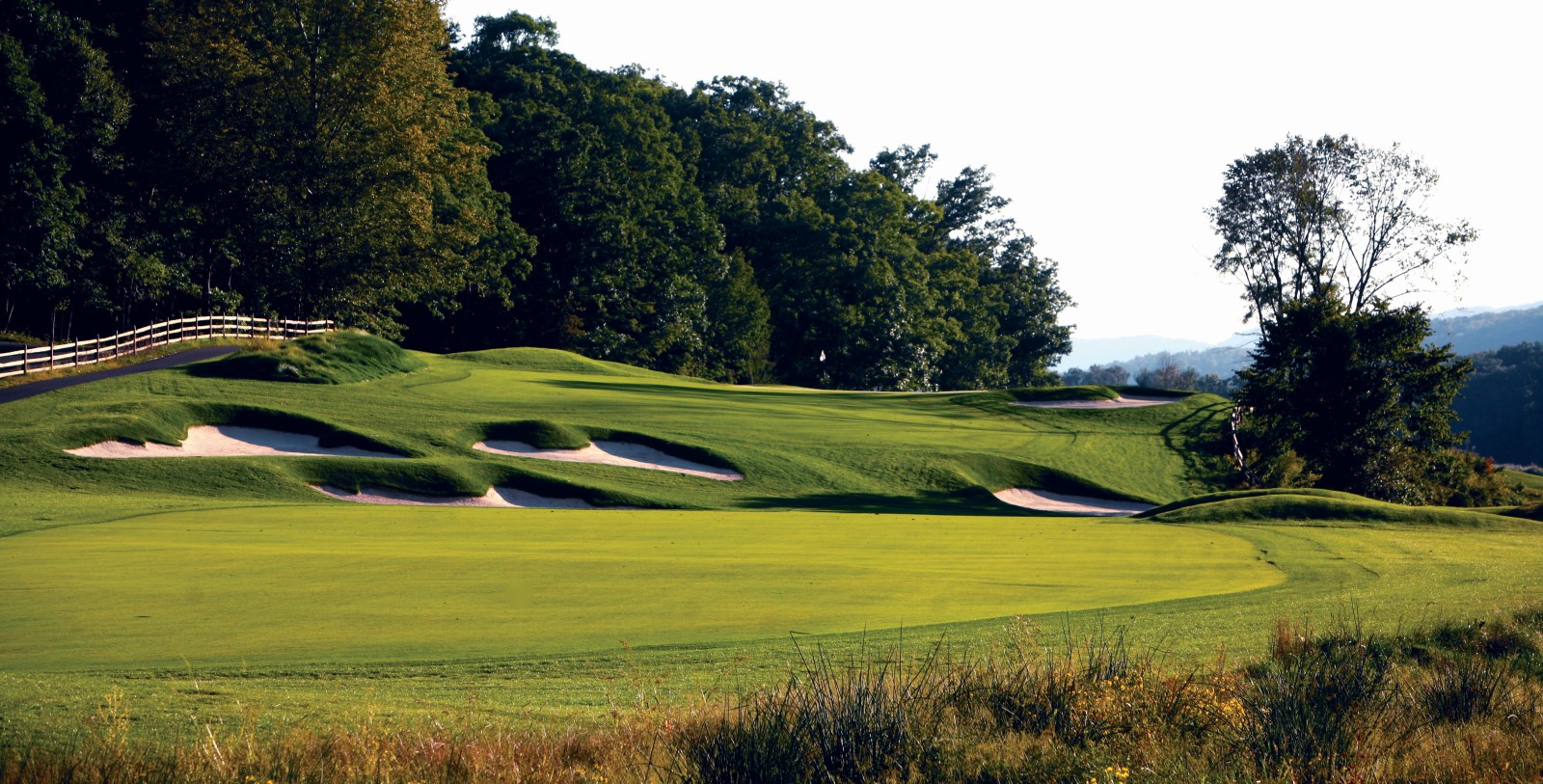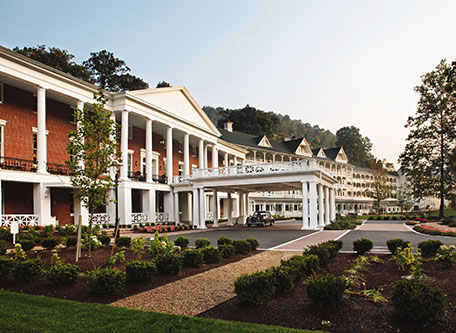Receive for Free - Discover & Explore eNewsletter monthly with advance notice of special offers, packages, and insider savings from 10% - 30% off Best Available Rates at selected hotels.
golf
Discover the Omni Bedford Springs Resort historic Old Course, which has been renovated by the likes of A.W. Tillinghast and Donald Ross.
As the popularity of the Omni Bedford Springs Resort reached new heights in the late 19th century, its leadership chose to introduce golf to its growing clientele. They specifically commissioned landscape architect Spencer Oldham to spearhead the creation of a challenging, yet enjoyable, 18-hole course right next to the resort. Picking land that faced the stunning Alleghany Mountains and Cumberland Valley, the fairways were both intimidating and inspiring. The entire length of the course measured a total of 6,000 yards—massive for an era when the normal golfer relied on wooden clubs. Oldham’s work was well received among the nation’s golfers, who began playing on the course in droves over the following decades. Nevertheless, the resort’s leadership opted to renovate the fairways just a decade after they opened, hiring a young A.J. Tillinghast to lead the project. Only his second course at the time, Tillinghast proceeded to reduce the number of holes by half. The holes he did leave were nonetheless renovated into some of the most majestic appearing in the entire United States. Indeed, his most iconic course was what many regard as his signature hole, the gorgeous “Tiny Tim.” (Tillinghast himself would go on to have an incredibly productive career in golf, ultimately designing more than 265 different courses throughout his lifetime.)
But in 1923, the resort decided to renovate the course once more, this time with the help of noted golf professional Donald Ross. Already an established fairway designer, Ross completed restored the golf course back to 18 holes. Despite the change, Ross preserved a lot of what Oldham and Tillinghast created when they were working at the site. In fact, Ross retained four of Tillinghast’s altered courses, including the “Tiny Tim.” Ross also left his own indelible mark on the course, particularly with the new holes that he installed in the back nine. The revitalized golf course at the Omni Bedford Springs Resort built a considerable reputation as the century continued, eventually building an identity as the “Old Course.” Since then, the course has entertained countless golfers from around the world, regardless of their skill level. In fact, some of the most illustrious people have played on the Old Course over the years, including golfing legend Arnold Palmer and former President George W. Bush. The Omni Bedford Springs Resort has also endeavored to preserve its historical integrity, too, with a massive restoration taking place under the direction of Ron Forse in 2005. (Much of the work conducted specifically went toward refurbishing the final two holes back to their former glory.) A round of golf on these historically significant tees is a must-play for golf enthusiasts of all levels.
-
About the Location +
The Omni Bedford Springs Resort is actually recognized by the U.S. Department of the Interior as both a National Register of Historic Places District, as well as a National Historic Landmark District. As such, the entire facility is protected by the federal government for its significant historical properties. The U.S. Department of the Interior identified some 23 different locations on-site that ultimately contributed to the historical nature of the resort in some fashion. Those structures are spread across 300-acres of land in a narrow valley formed by a tranquil creek called, “Shober’s Run.” The resort itself was developed around seven, historic mineral springs that are still known today as “Black,” “Crystal,” “Iron,” “Limestone,” “Magnesia,” “Sulphur,” and “Sweet,” While all seven of the springs ingratiated themselves among the resort’s earliest patrons, there was one that stood out above all the rest—the Magnesia Spring. Guests could originally access this well over at Constitution Hill, which is located close to the Colonial Building and Shober’s Run. The Anderson family constructed a Greek Revival-themed spring house for the body of water, although it was later removed in 1987. Many additional facilities reside over a Federal Hill, including most of the resort’s lodgment buildings.
The whole facility resides along U.S. Route 220, which cuts through the heart of Bedford, Pennsylvania. Now a borough for the eponymous Bedford County, it was first settled in the mid-1700s by colonial settlers heading west into the Allegheny Mountains. One of the most historic events to transpire within the town occurred shortly after the American Revolution, when President George Washington arrived in Bedford to put down the Whiskey Rebellion. The uprising had spawned among angry distillers in western Pennsylvania, who had become incensed by a new national tax on liquor that sought to pay off the country’s war debt. Whiskey was essential to life for small farmers in the region, as it was used as a form of currency at a time when printed money was scarce. The distillers attacked local officials in response to the law, and eventually burned the home of the area’s main tax inspector in July 1794. After several days of fruitless negotiations, President George Washington led an army out to western Pennsylvania in order to quell the movement. Fortunately, no blood was shed and resistance to the new tax dissipated in the face of such overwhelming force. While critics such as future President Thomas Jefferson were alarmed with the show of government strength, Washington’s supporters agreed that it was a necessary step in establishing federal power throughout the young United States.
-
About the Architecture +
A.W. Tillinghast: Affectionately known as “Tillie” by contemporaries, A.W. Tillinghast would go down in history as one of the most accomplished golf course architects in the first half of the 20th century. Unlike many other golf professionals at the time, Tillinghast discovered the game when he was already a young man. His interest in the sport specifically emerged after meeting the great Old Tom Morris during a trip to St Andrews, Scotland, in the 1890s. Tillinghast subsequently received a few private lessons from the renowned golfer, thus solidifying his love for the game. Upon his return to the United States, Tillinghast participated in numerous tournaments like the U.S. Amateur Championship. (Despite his passion, Tillinghast never placed very high in the competitions.) But Tillinghast began designing golf courses around the same time, too, beginning with his help on the Shawnee Country Club in 1911. Tillinghast walked away from the experience with an even greater appreciation for golf. As such, he began crafting many other courses across America over the next three decades. In fact, historians today credit Tillinghast with creating more than 265 different golf courses throughout his entire career! Among his most celebrated designs included the Winged Foot Golf Club, Baltusrol Golf Club, the San Francisco Golf Club, and of course, the Old Course at the Omni Bedford Springs Resort & Spa. Some of his courses—such as the Winged Foot Golf Club and the Baltusrol Golf Club—eventually hosted various PGA-sponsored tournaments like the PGA Championship and the U.S. Open. Tillinghast is thus remembered for his profound influence on golf. Indeed, he was even inducted into the World Golf Hall of Fame in commemoration of his contributions.
Donald Ross: Few other golf course designers have had such an impact on the sport of golf than the legendary architect Donald Ross. Born in Dornoch, Scotland, Ross’ legendary career began when he apprenticed under Old Tom Morris at historic St. Andrews during the late 1890s. He harnessed several important skills from Morris that ranged from club maintenance to landscaping. Ross then used his education to parlay a job at the Royal Dornoch Golf Club near his childhood home. Unfortunately for Ross, the pay was abysmal. With the encouragement of Scottish expat named Robert W. Willson, Ross decided to try to find more rewarding work at one of the many new professional golf facilities that had started opening across the United States. Willson subsequently financed Ross’ trip across the Atlantic in 1899, who helped him settle down just outside of Boston, Massachusetts. Ross accepted a job as the resident golf pro at the Oakley Country Club, where he left an immediate impression upon its members. Word soon spread of his talents, which eventually attracted the attention of prominent businessperson James Walker Tufts. In the midst of developing the resort town “Pinehurst” within the North Carolina sandhills, Tufts decided to hire Ross to head the new settlement’s golf club. Ross headed south that winter, although not without some cajoling from friends who doubted the entire endeavor.
Nevertheless, Ross went to work in 1901, serving as the primary golf instructor for a single, 18-hole course created a few years prior by Dr. Leroy Culver and John Dunn Tucker. Ross decided to completely renovate its fairways after conferring with Tufts, thus jumpstarting the work on the future Pinehurst No(s). 1 – 4 over the next two decades. Over time, they quickly became the treasures that Tufts had originally envisioned. Their success further catapulted Ross’ reputation throughout the United States, inspiring many other destinations to hire him to design their respective courses. In all, Ross would create (and redesign) over 400 unique golf courses across the country, with some of his most notable being at the Seminole Golf Club, Oak Hill Country Club, and the Aronimink Golf Club. Ross was also commissioned to renovate the Old Course at the Omni Homestead Resort in 1913. He subsequently transformed the layout into a stunning system of 18 different holes that blended in seamlessly into the surrounding countryside. Ross continued to work well into his seniority, often returning to Pinehurst to modify his first four professionally made courses. When he finally died in 1948, he had managed to leave a legacy that few others in the world of golf have come close to matching ever since. In fact, Ross’ legacy is still so great today that the World Golf Hall of Fame even inducted him posthumously several decades later in 1979.
-
Famous Historic Golfers +
Arnold Palmer, winner of seven major golf championships that include the PGA Championship and the Masters Tournament.
George W. Bush, 43rd President of the United States (2001 – 2009)


































